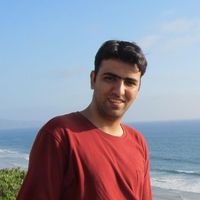- Optical Communication, Optical wireless Communications, Visible Light Communication, Visible Light Communications, MIMO-OFDM systems, Orthogonal Frequency Division Multiplexing (OFDM), and 20 moreOptical Fiber Communications, Fiber Optics, Information Theory, Information Theory and coding, Network coding, Coding Theory, Coding, Combinatorial Design Theory, Combinatorial Design, Combinatorics, Wireless Communications, Wireless networks, Optical Networks, Nonlinear Optics, Fiber Optic Sensors, Digital Modulation, Modulation, Modulation techniques, Optical Communications, and Indoor Optical Wireless Communicationsedit
Research Interests: Orthogonal Frequency Division Multiplexing (OFDM), Adaptive Modulation and Coding (AMC), Orthogonal Frequency Division Multiple Access (OFDMA), Modulation, Free Space Optics, and 15 moreFREE SPACE OPTICAL COMMUNICATION, OFDM, Modulation techniques, Visible Light Communication, • Optical communication and free space optical communication (FSO), Indoor Optical Wireless, Free Space Optical Communications, Indoor Optical Wireless Communications, Combinatorial Design Theory, FSO, Wireless Communication, Free Space Optical Communication, Combinatorial Design, Visible Light Communications, Hadamard, and Hadamard Matrices
Research Interests: Optical Communication, Modulation, Optical wireless Communications, Optical Communications, Modulation techniques, and 7 moreDigital Modulation, Visible Light Communication, Indoor Optical Wireless, Indoor Optical Wireless Communications, Combinatorial Design Theory, Combinatorial Design, and Visible Light Communications
Research Interests: Optical Communication, Optical Networks, Modulation, Access Networks, Optical wireless Communications, and 10 moreoptical CDMA, Modulation techniques, Visible Light Communication, Ocdma, Optical Code Division Multiple Access, Indoor Optical Wireless, Indoor Optical Wireless Communications, Combinatorial Design Theory, Combinatorial Design, and Visible Light Communications
Research Interests: Optical Fiber Communications, Optical Communication, Modulation, Optical wireless Communications, Free Space Optics, and 9 moreFREE SPACE OPTICAL COMMUNICATION, Modulation techniques, Digital Modulation, Visible Light Communication, Indoor Optical Wireless, Free Space Optical Communications, Pulse Amplitude Modulation (PAM), Indoor Optical Wireless Communications, and Visible Light Communications
Research Interests: Optical Fiber Communications, Fiber Optics, Optical Communication, Fibre Optic Communications, Modulation, and 10 moreOptical wireless Communications, FREE SPACE OPTICAL COMMUNICATION, Modulation techniques, Digital Modulation, Indoor Optical Wireless, Free Space Optical Communications, Indoor Optical Wireless Communications, Combinatorial Design Theory, Combinatorial Design, and Optical Systems (Advanced Optical Modulation and Multiplexing Techniques
Research Interests: Optical wireless Communications, Free Space Optics, FREE SPACE OPTICAL COMMUNICATION, Ultraviolet, • Optical communication and free space optical communication (FSO), and 6 moreFree Space Optical Communications, FSO, Wireless Communication, Free Space Optical Communication, Wireless optical communication, Spectral Amplitude Coding, and Free-Space Optics
Research Interests:
Research Interests:
The impact of the compensator's location along the optical fiber on a variation of four-wave mixing power penalty is investigated theoretically and numerically for dispersion-managed fibers in wavelength division multiplexing systems. The... more
The impact of the compensator's location along the optical fiber on a variation of four-wave mixing power penalty is investigated theoretically and numerically for dispersion-managed fibers in wavelength division multiplexing systems. The power penalty is analyzed for fibers with different attenuation coefficients and lengths, and the optimum positions for the compensator along the fiber is discussed in cases of both dispersion compensation of each fiber section between two amplifiers and whole-compensation.
Research Interests:
Research Interests:
Research Interests:
Research Interests:
Impulse-radio UWB (IR-UWB) transceivers are quite interesting since they can achieve high data rate while consuming low power. But UNII Band interferers are a serious problem for using the whole spectrum in IR-UWB. Also the short range of... more
Impulse-radio UWB (IR-UWB) transceivers are quite interesting since they can achieve high data rate while consuming low power. But UNII Band interferers are a serious problem for using the whole spectrum in IR-UWB. Also the short range of UWB is a serious limitation to this technology. Here we have proposed a solution to overcome both of the above mentioned problems. Matched filter concept shapes the output noise according to its spectrum so it can act as a noise filter. Matched filter is implemented in analog domain by designing an all optical UWB pulse featuring notches that can be tuned to a certain frequency. Therefore, any narrowband interferer can be nulled out passing through the matched filter. Also no transmission is done in the spectrum of the narrow band system so no interference is caused by UWB system. On the other hand since the pulse is implemented fully optically, by using UWB over fiber, the UWB range can be greatly extended. Modified Hermite polynomials have unique properties which are used for designing an optical UWB pulse with frequency nulls in its spectrum. For optical implementation of the proposed UWB pulse, Gaussian laser beams are combined to provide a signal with similar properties of Modified Hermite polynomials. The proposed system consists of a single wave length laser source, optical delay, power splitter/combiner, a length of single mode fiber (SMF) and a photo detector (APD). The simulation results shows that for short range communication the proposed architecture can tolerate large in band interferers up to 30 dBm. For long range the tolerance is degraded to 0dBm interferer power which is still quite high.
Research Interests:
Research Interests:
We have investigated the dependence of resonance frequency of micro-cavity on its geometry for T-shaped beam splitter using finite difference time domain (FDTD) method. We derived resonance frequencies and output powers for elliptical... more
We have investigated the dependence of resonance frequency of micro-cavity on its geometry for T-shaped beam splitter using finite difference time domain (FDTD) method. We derived resonance frequencies and output powers for elliptical cavity with various radii in both vertical and horizontal directions (X and Y directions). The results showed that resonance frequency is highly related to the cavity radii and broad range of frequencies is accessible. We also discussed T-beam splitter performance for a rotated cavity by different degrees. We observed that rotation of the elliptical cavity make changes only in power transmission and interestingly resonance frequencies become fixed. By setting the cavity angle at 45 degree we get the equivalent division of power with the transmission efficiency of 40% per each output port. Results showed that rotation of the elliptical cavity is an appropriate and easy way to modify the division of input power into two output waveguides.
